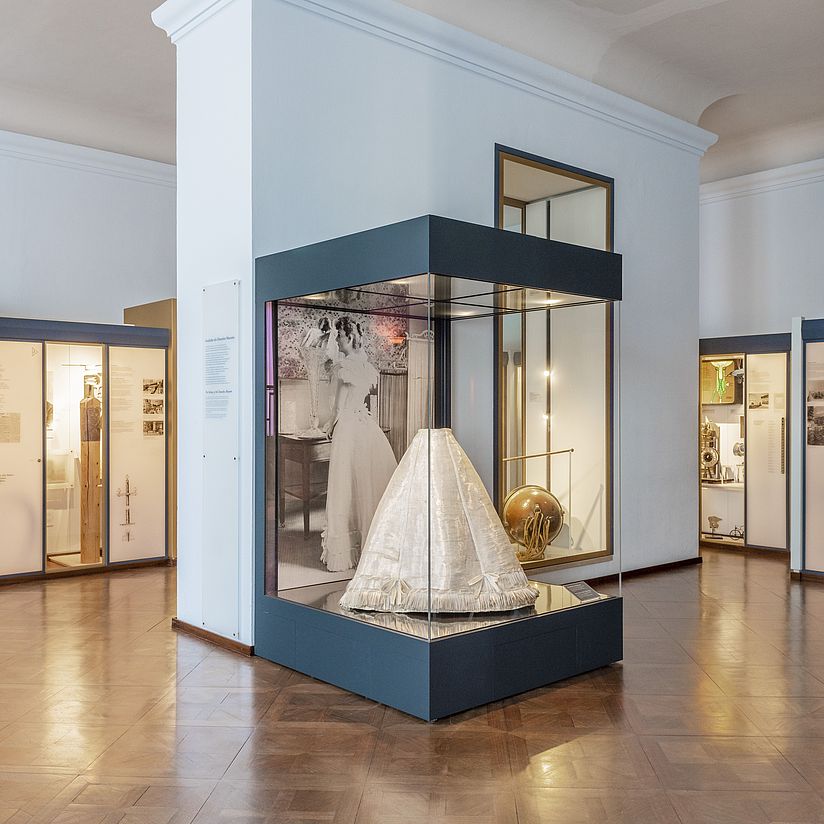
Das Glasfaserkleid in der Ausstellung Museumsgeschichte Photo: Deutsches Museum | Christian Illing
Conservation science
Dress code fibreglass
Glass fibers as light guides have become indispensable for our modern and networked society. But a dress made of fiberglass seems rather unusual at first glance.
Content
Dress code fibreglass – The glass fibre dress of Princess María Eulalia
Funded by
Freundes- und Förderkreis des Deutschen Museums; Aktionsplan II der Leibniz-Forschermuseen; Rakow Grant for Glass Research, Corning Museum of Glass, Corning, NY
- Conservation science
- Deutsches Museum - Museumsinsel
- Material and Production
Edited by
Dr. Charlotte Holzer
Wissenschaftliche MitarbeiterinRestaurierung und Ausstellungstechnik, Ausstellungsprojekt Historische Luftfahrt, Schiffe und Meer
Dr. Marisa Pamplona Bartsch
Leitung Abteilung Konservierungswissenschaft
Ralf Spicker
CuratorDepartment of metals, mechanical engineering and textile technology
Project description
The textile conservator Charlotte Holzer researched and conserved the extraordinary dress in her PhD project from 2015 to 2020. The results are presented in the “History of the Museum” exhibition and in a digital exhibition.
A dress made of glass
Long before synthetic textiles became a fashion trend, a glass fibre dress caused a sensation at the Chicago World’s Fair in 1893. The glass fibre dress was specially made for the World’s Fair by the glassblower Hermann Hammesfahr on behalf of the Libbey Glass Company from Toledo (Ohio). Spanish Princess María Eulalia was so thrilled by the shimmering and shiny robe that she later received a replica.
The manufacturing of the dress demanded a lot of effort: The glass blowers heated a glass rod with a gas lamp and pulled the molten glass into fine threads. The luxurious and fashionable evening gown was tailored from glass and silk fibres woven into a fabric.
Back in its old glory
Princess María Eulalia’s sister was married to Prince Ludwig Ferdinand of Bavaria. She donated the glass fibre dress to the Deutsches Museum in 1924.The dress was stored for many years, under sometimes difficult conditions, in the depot of the Deutsches Museum. The bodice is missing and the skirt was in a bad state of preservation.
Therefore, the skirt had to be conserved by a textile conservator. It took over four years of research, training in methodologies of glass conservation and about 500 hours of handicraft work.
Current
- Art Glass Forum, New York, 10.05.2022
The Glass Dress. A Conservation Story in the Deutsches Museum - Glasfaserkleid aus dem 19.Jahrhundert
IQ-MAGAZIN, 29.3.2021
https://www.br.de/mediathek/podcast/iq-magazin/brasilianische-mutante-unsichere-mailserver-glasfaserkleid-aus-dem-19-jahrhundert/1822237 - Zerbrechliche Schönheit
Deutsches Museum Pressemitteilung, München, 25.3.2021
https://www.deutsches-museum.de/museum/presse/meldung/zerbrechliche-schoenheit
Picture gallery
Subprojects

Das Glasfaserkleid in der Ausstellung Museumsgeschichte Photo: Deutsches Museum | Christian Illing
Digital exhibition
The digital exhibition will make the results of the research and conservation of the glass fibre dress accessible, regardless of time and space. Based on the glass fibre dress as an object, visitors will be able to get new perspectives on the exhibit.

Blick in die Vitrine mit dem Glasfaserkleid Photo: Deutsches Museum | Christian Illing
Temporary exhibition
For the first time since the “World Columbian Fair” in 1893, the glass fibre dress of Infanta María Eulalia of Spain is once again accessible to the public. The fragile and rare gown came into the collection of the Deutsches Museum in 1924 via the sister of the Spanish princess. Over the past few years, it has been carefully conserved and researched. The results are being presented in a small temporary exhibition.
Link auf die Sonderausstellung
Dresscode Glasfaser
Liveübertragung aus der Sonderausstellung, 29.4.2021
https://www.youtube.com/watch?v=68gRE6QRQ3U&t=1s
Rock on Rolls – Der lange Weg des Glasfaserkleids
Making-of zur Ausstellung „Dresscode Glasfaser“, Sabine Pelgjer, 31.3.2021
https://www.youtube.com/watch?v=a3wlbvYomgY&list=RDCMUCCjFn707ij2b4qtsKe7901Q

Restauratorin Charlotte Holzer testet Methoden zur Reinigung an einer handgefertigten Glasfaserkrawatte im Corning Museum of Glass, Oktober 2016 Photo: Deutsches Museum | Astrid van Giffen
Forschung und Restaurierung
The research on the glass fibre dress focused on understanding damage mechanisms and causes in order to be able to develop methods for the preservation of the heavily damaged dress. The project was part of Charlotte Holzer’s dissertation at TU Munich and the results were used to conserve the dress from December 2016 to January 2020.
The condition of the object was very instable. After decades of storage in the depot, the dress was extremely dirty and the glass fibres had degraded. Fibre bundles were broken and the fabric was torn, the silk lining was disintegrating. The upper part has not been found to this day. With a mapping, the damages were classified and documented. Through comparison with historical photographs in the museum as well as conversations with staff, the damage processes and causes for deterioration could be traced. Further insights were gained by analysing material samples and comparing them with other fibreglass products made by the Libbey Glass Company in 1893.
Since there had been no comparable conservation projects on historical glass fibre textiles before, the Corning Museum of Glass funded the necessary research on surface cleaning with the Rakow Grant for Glass Research 2016. The methods for securing the fabric, the development of a substructure for the skirt and the requirements for storage were discussed with expert colleagues from the partner institutions and carried out in the conservation research laboratory.
From our blog
Deutsches Museum Blog, 2017–2019
Das Glasfaserkleid. Vom Material, das nie in Mode kam
Deutsches Museum Podcast, Ralph Würschinger, 18.4.2019
Events
Interactive events
- Rabea Beschta, Charlotte Holzer, Dresscode Glasfaser, Deutsches Museum Science Summer, 31.5.2021
- Charlotte Holzer, Restaurierung im Forschungslabor, Das Glasfaserkleid der Infantin Eulalia von 1893, Europäisches Kulturerbejahr – Interaktive Vortragsreihe im Deutschen Museum Zentrum für Neue Technologien / Lange Nacht der Museen, Oktober 2018
Lectures
- Charlotte Holzer, How to Preserve the Story of a 19th-Century Glass Fibre Dress, Material Authenticity of the Ephemeral, Deutsches Museum / Leibniz Gemeinschaft, München 16–18. Oktober 2017
- Charlotte Holzer, A Cleaning Protocol for the Glass Fibre Dress in the Deutsches Museum, Future Talks 2017, Neue Sammlung, München 11.–13. Oktober 2017
- Charlotte Holzer, Restaurierung im Labor: Einsatz instrumenteller Analytik bei der Reinigung eines Glasfaserkleides, Junges Forum für Sammlungs- und Objektforschung, Kustodie der Georg-August-Universität Göttingen, 28–29. September 2017
- Charlotte Holzer, Auf der Suche nach historischen Glasfasertextilien – Ein Reisebericht, Stein- und Textilrestaurierung an der Universität für angewandte Kunst Wien. Jubiläumstagung, Wien 28. April 2017.
- Charlotte Holzer: Ein Kleid aus Glasfasern von 1893 – Untersuchungen zu Geschichte und Technik, Tag der offenen Tür Atelier- und Werkstättengebäude des Bayerischen Nationalmuseums mit dem TUM Lehrstuhl für Restaurierung, Kunsttechnologie und Konservierungswissenschaft und der Archäologischen Staatssammlung, München, 15. November 2015
Publications
- Charlotte Holzer: Das Kleid aus Glas. Eine Restaurierungsgeschichte im Deutschen Museum, Deutsches Museum Studies, Band 8, München 2021, www.deutsches-museum.de/verlag/museum-sammlungen/ueber-das-museum/das-kleid-aus-glas/
- Charlotte Holzer, Restaurierung im Labor: Einsatz instrumenteller Analytik bei der Reinigung eines Glasfaserkleides, in: Siedl, Ernst; Steinheimer, Frank; Weber, Cornelia (Hg.): Objektkulturen der Sichtbarmachung. Instrumente und Praktiken. Junges Forum für Sammlungs- und Objektforschung, Bd. 2, Berlin 2018, S. 40–54, https://edoc.hu-berlin.de/handle/18452/20530
- Charlotte Holzer, Understanding historic glass fibre dresses and their needs in conservation, in: Glenn, Sarah; Smith, Katy (Ed.): Postprint ICON Textile Group Forum, Museum of London 21.5.2018, London 2018, pp. 118–131.
- Charlotte Holzer: Das Glasfaserkleid aus dem Deutschen Museum (Chicago 1893). Ein Abendkleid als Meisterwerk der Naturwissenschaft und Technik?, in: IIC Austria. Restauratorenblätter/Papers in Conservation, Bd. 34, 2017, S. 45–52.
- Charlotte Holzer, Ein Kleid aus Glas, in: Kultur und Technik, 2/2017, S. 24–26, www.deutsches-museum.de/fileadmin/Content/010_DM/060_Verlag/060_KuT/2017/2-17-Schönheit/Holzer-WEb.pdf
- Charlotte Holzer: Planning the Conservation of Infanta Eulalia’s Glass Dress, Poster, Recent Advances in Glass and Ceramic Conservation. ICOM-CC Glass and Ceramics Working Group Interim Meeting, Wroclaw 25.–29. Mai 2016.



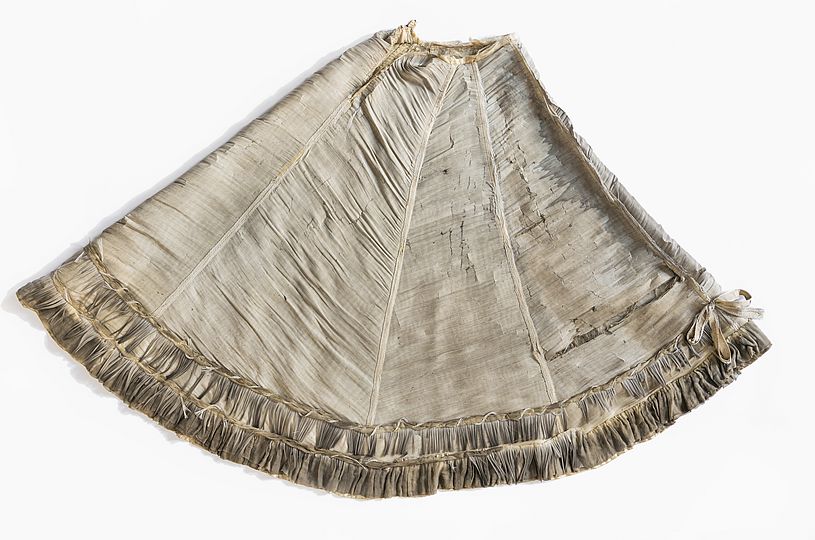
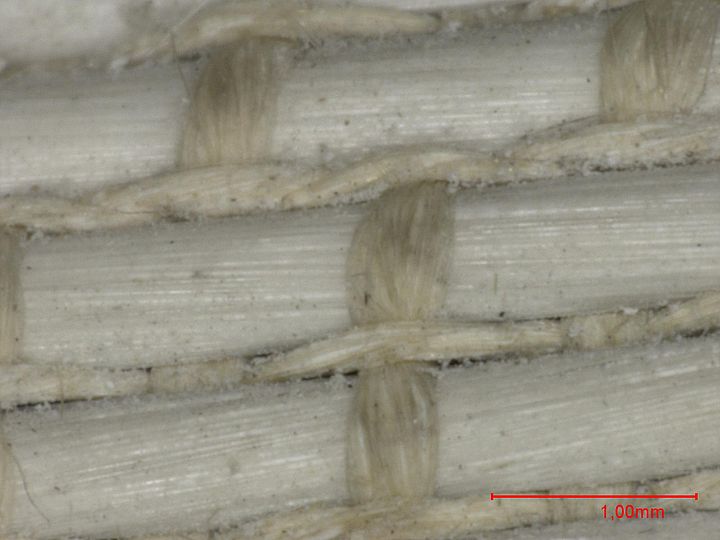
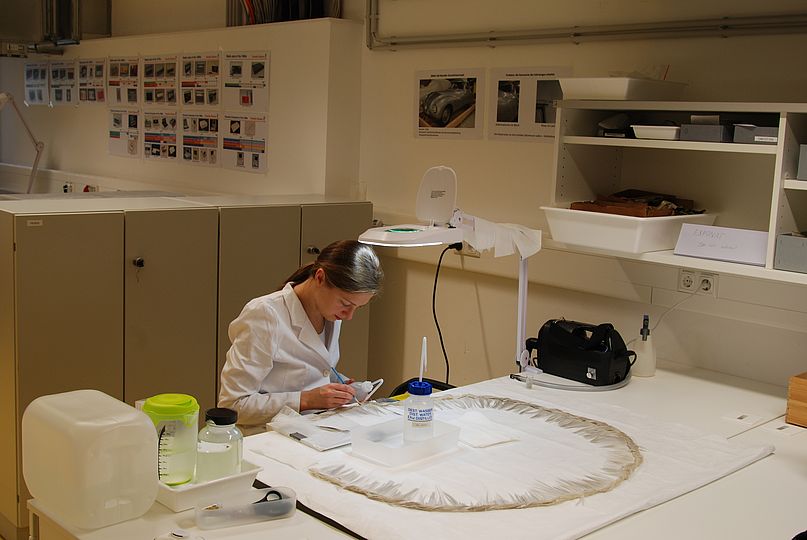
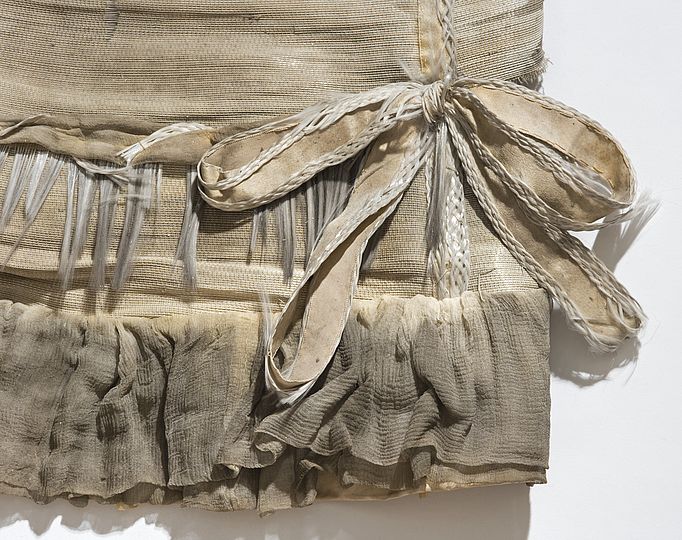
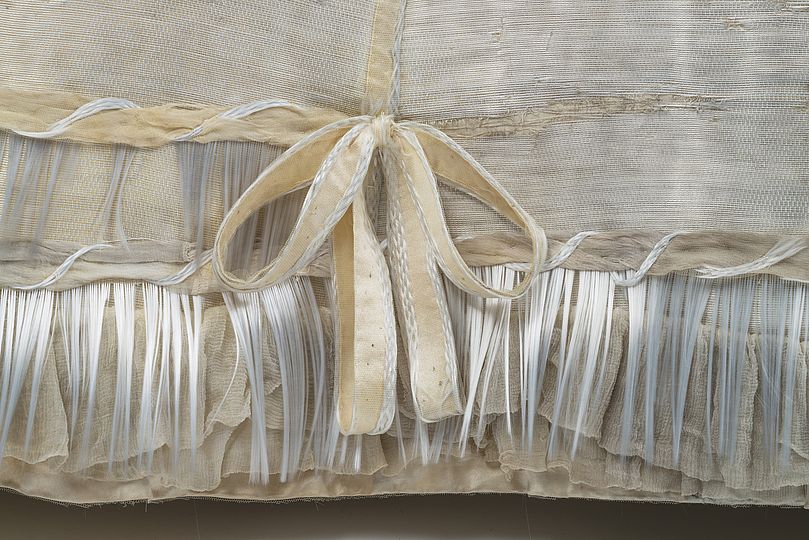
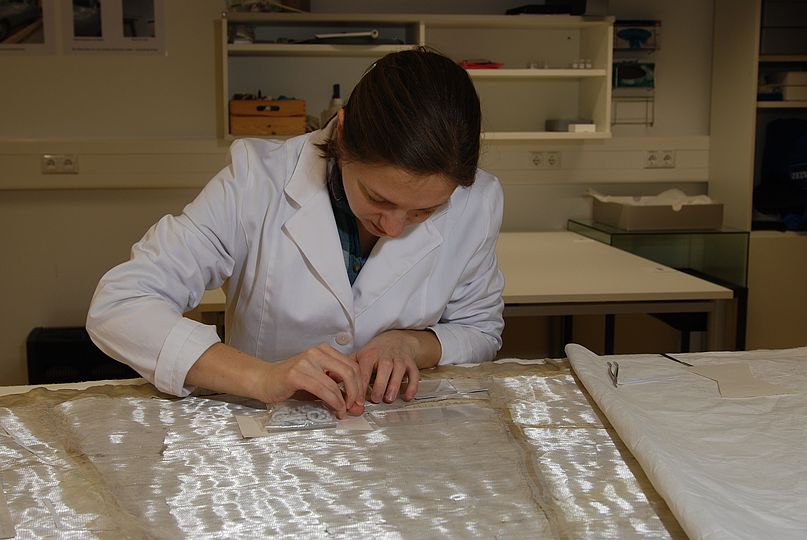


![[Translate to English:] [Translate to English:]](/assets/_processed_/7/7/csm_Acrylglas_Dachelement_Inv_Nr_2768_aaa44577a1.jpg)
![[Translate to English:] [Translate to English:]](/assets/_processed_/e/4/csm_Play_YagouRelaunch_Bild1_bf60a9b213.jpg)

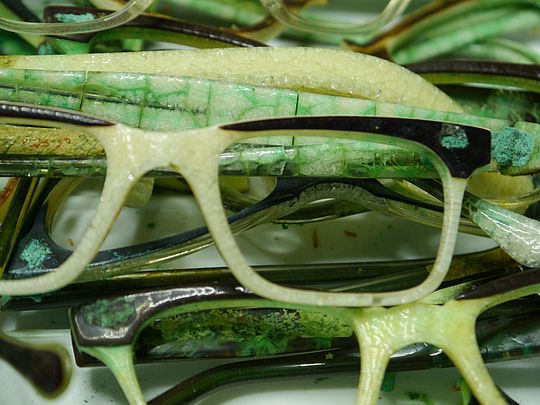
![[Translate to English:] [Translate to English:]](/assets/_processed_/6/f/csm_210528_2235_Lilienthal-Gleiter_47d1b47d12.jpg)